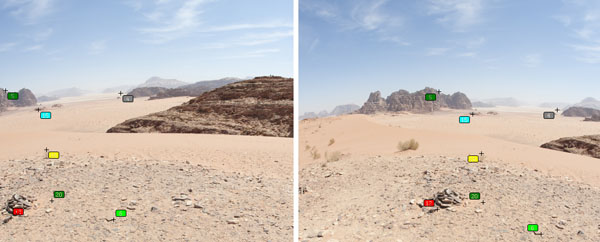Control points are positions within an image which have been precisely identified in at least one other image of a panorama. They are therefore located only in areas of overlap with another image. They are normally positioned on features or objects that are easy to identify as a consequence of clearly defined edges, lines, angles or areas of high contrast, and used to align adjacent images during the virtual reality stitching process.
Control points may be added automatically to a set of images by the software, but they may also be positioned manually by carefully examining pairs of overlapping images. Where possible, the selected points should be widely spaced as this is likely to give more accurate image alignment. Incorrectly placed control points may cause alignment errors in the panorama.

Each overlapping pair of images must have a minimum number of control points to enable the software to achieve alignment. In broad terms, one pair of control points is required for each parameter to be optimized. To optimize yaw, pitch and roll of the images, a minimum of three pairs of control points is required per per image pair. More pairs may be added, but too many control points merely places an increased burden on the image alignment software.
In the overlapping images above, seven control point pairs have been identified by matching pairs of coloured markers. Each pair identifies the same location in two images. The alignment process attempts to warp the images, using lens calibration parameters and control points, until the matching pairs of control points lie precisely on top of each other. The images can then be merged seamlessly.
Note that it is also important to set vertical control points where possible. These are inserted manually in overlapping single images and positioned along any convenient vertical lines. They help to ensure that the final panorama is correctly aligned and that the horizon does not bend up and down like waves on the sea. In some cases, such as the landscape panorama shown above, this may be very difficult or even impossible to achieve. In such cases, the final panorama can usually be adjusted by dragging the horizon in the appropriate direction, but the process is far from perfect.






